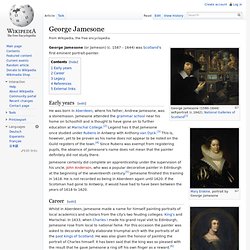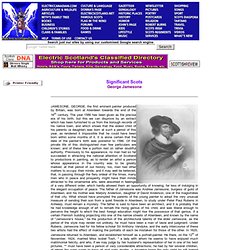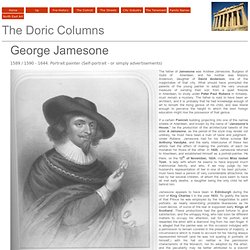

George Jamesone. George Jamesone (or Jameson) (c. 1587 – 1644) was Scotland's first eminent portrait-painter.

Early years[edit] He was born in Aberdeen, where his father, Andrew Jamesone, was a stonemason. Jamesone attended the grammar school near his home on Schoolhill and is thought to have gone on to further education at Marischal College.[2] Legend has it that Jamesone once studied under Rubens in Antwerp with Anthony van Dyck. This is, however, yet to be proven as his name does not appear to be noted on the Guild registers of the town.[4] Since Rubens was exempt from registering pupils, the absence of Jamesone's name does not mean that the painter definitely did not study there.
Career[edit] Whilst in Aberdeen, Jamesone made a name for himself painting portraits of local academics and scholars from the city's two feuding colleges: King's and Marischal. After hearing of the King's approval, many of the Scottish gentry desired to be painted by the now highly reputable George Jamesone. Legacy[edit] Overview of George Jameson. George Jamesone. JAMESONE, GEORGE, the first eminent painter produced by Britain, was born at Aberdeen towards the end of the 16th century.

The year 1586 has been given as the precise era of his birth, but this we can disprove by an extract which has been furnished to us from the borough records of his native town, and which shows that the eldest child of his parents (a daughter) was born at such a period of this year, as rendered it impossible that he could have been born within some months of it. It is alone certain that the date of the painter’s birth was posterior to 1586. Of the private life of this distinguished man few particulars are known; and of these few a portion rest on rather doubtful authority.
George Jamesone - Painter. Jamesone appears to have been in Edinburgh during the visit of King Charles I in the year 1633.

To gratify the taste of that Prince he was employed by the magistrates to paint portraits, as nearly resembling probable likenesses as he could devise, of some of the real or supposed early Kings of Scotland. These productions had the good fortune to give satisfaction, and the unhappy King, who had soon far different matters to occupy his attention, sat for his portrait, and rewarded the artist with a diamond ring from his own finger. After a life which must have been spent in great industry, and enjoying independence, and even wealth, Jamesone died at Edinburgh in 1644, and was buried without a monument in the Grey Friars’ Church there. It is indeed not without reason, that the portraits of Jamesone have frequently been mistaken for those of Vandyke. The Four Neukit Garden, which four hundred years ago was the favourite suburban retreat of Jamiesone where he drank the well water.
Domestic Annals of Scotland - Reign of Charles I. 1625 - 1637 Part D. His labours are thus spoken of in the family chronicle: ‘Sir Colin gave unto George Jameson, painter in Edinburgh, for King Robert and King David Bruces, kings of Scotland, and Charles I., king of Great Britain, and his majesty’s queen, and for nine more of the queens of Scotland their portraits, whilk are set up in the hall of Balloch, the soum of twa hundred three-score pounds.’ . . . .

‘For the knight of Lochow’s lady, and the first Countess of Argyle, and six of the lathes of Glenurchy their portraits, and Sir Colin his awn portrait, whilk are set up in the chalmer of dais of Balloch, [he gave] ane hundred fourscore pounds.' If we are to presume that Scots money is meant in all these instances, it would appear that this eminent artist was content to execute a bust portrait at a pound sterling!
Iconographia Scotica: or portraits of illustrious persons of Scotland engraved from the most authentic paintings &c with short biographical notices. By John Pinkerton, ... Page [unnumbered] THE Vandyke of Scotland, was son of Andrew Jameson, a builder, and was born at Aberdeen in 1586.
The portraits by him at Taymouth are said to have been executed before he studied in Flanders;* and as one piece there is dated 1635, it would appear that he was advanced in years before he visited Ru∣bens. He died at Edinburgh in 1644, aged 58; and was buried in the Gray-Friars churchyard. For some account of his works the reader may con∣sult the valuable "Anecdotes of Painting in England;" nor is much additional information to be procured. Dr. Jameson is the first Scotish painter on record; but eminent foreigners had visited Scotland, and painted illustrious portraits. Your Paintings - George Jamesone.